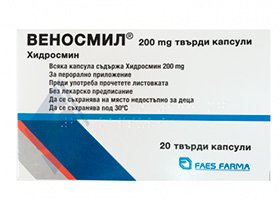
All iLive content is medically reviewed or fact checked to ensure as much factual accuracy as possible.
We have strict sourcing guidelines and only link to reputable media sites, academic research institutions and, whenever possible, medically peer reviewed studies. Note that the numbers in parentheses ([1], [2], etc.) are clickable links to these studies.
If you feel that any of our content is inaccurate, out-of-date, or otherwise questionable, please select it and press Ctrl + Enter.
Venosmil
Medical expert of the article
Last reviewed: 04.07.2025

Venosmil is a capillary stabilizing drug from the category of angioprotectors. Contains bioflavonoids.
ATC classification
Active ingredients
Pharmacological group
Pharmachologic effect
Indications Venosmila
It is used to relieve swelling and symptoms caused by chronic venous insufficiency (the drug can be used for a short period of time – a maximum of 2-3 months).
Release form
The medicinal substance is released in capsules, 10 pieces per blister pack. A pack contains 6 or 9 such packs.
Pharmacodynamics
The active element of the medicine is hydrosmin, the chemical properties of which allow it to be classified as a flavonoid. It is a standard mixture that includes the components 5,3'mono-O-(β-hydroxyethyl)-diosmin, as well as 5,3'-di-O-(β-hydroxyethyl)-diosmin.
The medicinal effect of hidrosmin has not yet been fully studied, but it is possible to note the presence of a relationship with the slowing down of catecholamine degradation processes - mainly due to the inhibition of the activity of catechin-O-methyltransferase. Although it has not yet been possible to accurately determine the therapeutic effect of the drug, it is still possible to identify 4 main properties provided by hidrosmin:
- strengthening the strength of capillary walls, the permeability of which can be caused by the action of bradykinin with histamine. The substance also prevents capillary fragility, which can develop with an incorrect nutritional regime;
- improvement of hemorheological parameters of erythrocytes, reduction of blood viscosity and increase in the ability of erythrocytes to deform;
- influence on venomotor tone – gradual stimulation of constant contractions of smooth muscles in the area of the venous wall;
- creation of optimal conditions for improving lymphatic circulation processes. Hydrosmin provokes the expansion of lymph ducts and at the same time increases the speed of its movement, due to which the lymphatic outflow improves.
Venosmil helps improve clinical manifestations of peripheral venous insufficiency (feeling of heaviness or pain, as well as swelling), which is why it differs from the effect of placebo. There is no doubt that the active element of the drug has a significant effect on complications in venous stasis caused by varicose vascular dilatation in the legs.
 [ 1 ]
[ 1 ]
Pharmacokinetics
After oral administration of a single dose of the drug, a healthy person has a 2-phase curve of plasma drug values relative to time. The initial Cmax is observed after 15 minutes, and then the indicator slowly decreases. Four hours after administration, another increase in drug values is observed, reaching a stable level within 5-8 hours after administration. Then the indicators inside the plasma decrease. After 24 hours, the substance is almost not observed in the body.
The half-life of hydrosmin is 90% over 48 hours. The active ingredient of the drug is mainly excreted by the intestines (80% of the component). About 16-18% of the portion is excreted with urine on average.
 [ 2 ]
[ 2 ]
Dosing and administration
The medication is taken orally, with food, washed down with plain water.
It is necessary to prescribe the medicine in a dosage of 0.2 g (1 capsule) three times a day (taken at intervals of 8 hours). Such a treatment cycle should last for 2-3 months.
 [ 4 ]
[ 4 ]
Use Venosmila during pregnancy
There are no clinical tests to determine the possibility of using Venosmil during pregnancy. Preclinical trials have not revealed any direct or indirect negative effects on the course of pregnancy, fetal development, or the process of labor and postnatal development. Before starting to use the drug, you should evaluate the possible benefits and risks of complications from taking it.
There is no information regarding the excretion of the drug in breast milk, which is why it should not be used during breastfeeding.
Contraindications
Contraindicated for use by people with intolerance to the components of the drug.
Side effects Venosmila
The therapy is often tolerated without complications. Only people with hypersensitivity may experience negative effects. Among the side effects that develop most often are:
- digestive disorders: nausea and stomach pain;
- epidermal lesions: itching or rash;
- CNS disorders: headaches, feeling of weakness and dizziness.
 [ 3 ]
[ 3 ]
Storage conditions
Venosmil should be kept in a place closed to small children. Temperature indicators should not exceed 30°C.
Shelf life
Venosmil can be used within 5 years from the date of manufacture of the therapeutic agent.
Manufacturer
Attention!
To simplify the perception of information, this instruction for use of the drug "Venosmil" translated and presented in a special form on the basis of the official instructions for medical use of the drug. Before use read the annotation that came directly to medicines.
Description provided for informational purposes and is not a guide to self-healing. The need for this drug, the purpose of the treatment regimen, methods and dose of the drug is determined solely by the attending physician. Self-medication is dangerous for your health.

